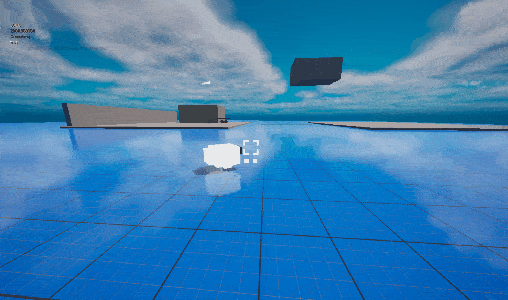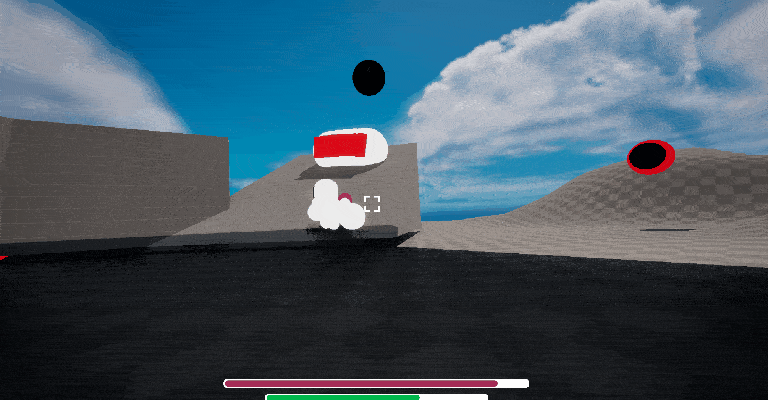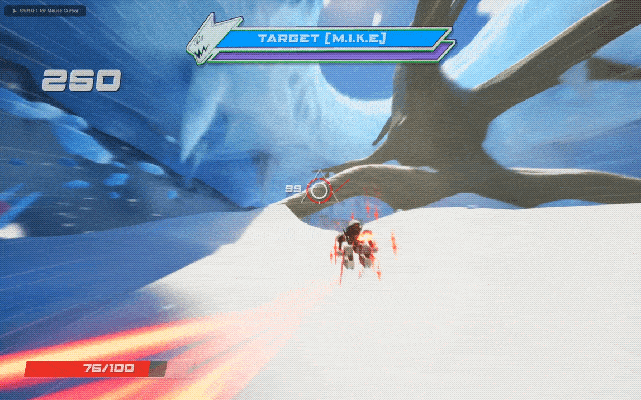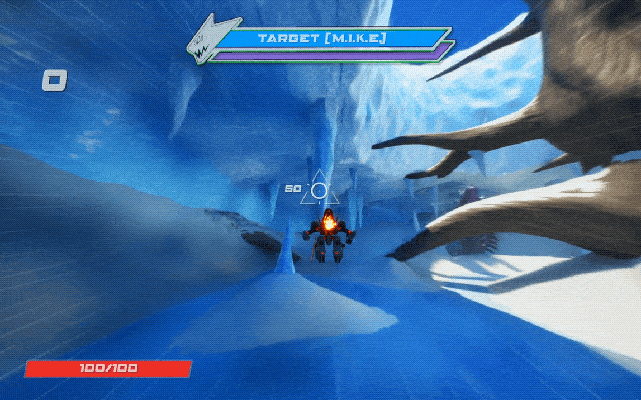
FREEZING FRICTION
GAME DESIGNER. TECHNICAL DESIGNER.
FAST-PACED THIRD PERSON ACTION where you skate and grapple through icy caverns to unleash fire, through blade and bullets, on massive worms and their spawn.
-
GENRE: Third-Person Action
TEAM SIZE: 17
PROJECT TIMELINE: 12 Weeks | 2024
ENGINE: Unreal Engine 5
-
Designed and implemented high-octane third-person character, camera, and controls
Designed and implemented melee and ranged combat toolkit
Collaborated effectively with other designers to define our combat loop
Collaboratively designed and implemented 5 enemy types, including the worm
Designed and implemented player HUD
Collaborated with artist, defining requirements and supporting technical implementation
Informed design decisions via process of playtesting and iteration
Engaged in substantial pre-production process, involving ideation and prototypes
DESIGNING CORE GAMEPLAY
PRE-PRODUCTION
Beginning the project as a small team of designers, we were tasked with developing a third-person shooter merging combat and traversal.
RAPID PROTOTYPING
The team took a bottom-up or mechanics-driven approach to developing our concept. This meant realizing and validating our designs rapidly in-engine to “find the fun.”
Many of my prototypes explored 3Cs models (character, camera, controls) which aimed to create and experiment with engaging verbs that could form as the foundation for a more concrete game loop.
E.g. early prototypes combining a grappling hook and projectile weapon.
TEAM ALIGNMENT
These prototypes were used to inform our team’s direction. While initial prototyping was our opportunity to diverge and explore, we then converged, taking a critical look at our work to establish best next steps. We involved both internal and external playtests, choosing to follow through on game elements that were most successful.
E.g. iterated on initial skating concept, introducing slopes and verticality to investigate merging it with grappling.
E.g. integrated grapple with boss enemy, allowing them to grapple to and get pulled by the enemy.
E.g. iterated on melee combat, enhancing game feel, investigating resource systems, and integrating grapple mechanics.
DEFINING THE CONCEPT
The repeated process of diverging, designing and prototyping concepts for the sake of exploration, and converging, analyzing and validating concepts to move forward, allowed us to define our core concept. This concept was conveyed to peers and stakeholders via documentation.
Elevator pitch slide from pitch deck.
Zubek model design documentation (akin to MDA model) breaking down the game’s mechanics, the emergent dynamics they create, and the resulting player experience.
Onion diagram design documentation, detailing game loops present in the proof-of-concept prototype. Brings attention to our core loop.
DEFINING DESIGN PILLARS
With the project moving into the next phase of development and introducing new team members, defining our design direction was critical.
HIGH OCTANE
Fast-paced is a key adjective in describing the game’s fun. The player moves and acts quickly, skating and grappling through the environment to combat hoards of enemies. Moreover, the game promotes player empowerment, aiming to convey a sense of power in the player’s actions. Through our game, players should experience the fantasy of a high octane killing machine.
MECHANICAL MASTERY
The player character possess a small set of core mechanics possessing a high skill ceiling, creating room and reward for mastery. Aim for the highest score.
MASSIVE ENEMY
Plain and simple, the game’s giant worm enemy is our most eye catching feature and USP. The game should be explicitly designed to emphasize the massive enemy.
PROOF-OF-CONCEPT PROTOTYPE
The project’s pre-production deliverable involved a proof-of-concept prototype. It intends to clarify and validate our concept, all within a single playable build.
My proof-of-concept prototype contributions included:
High octane character controller, enabling players to jump, double jump, skate, and grapple across the arena. Validated the fun in combining skating and grappling movement mechanics.
Dynamic weapon input system, allowing players to hold or tap the attack input, shooting or slashing respectively. Enabled a two button control scheme, one for grappling and another for using either weapon.
Ranged hitscan weapon implementation.
Polish and feedback. Included the implementation of VFX, squash and stretch, and hit stop.
UI to represent player health, score, and heat mechanic.
Flying and grounded enemy types. Enemies with simple properties, providing obstacles for players to overcome using the available verbs.
CHARACTER CONTROLLER
Designing and implementing the game's character controller was my most substantial contribution to the final game. Getting this right was critical, as fast-paced movement was core to our proof-of-concept’s fun.
The bulk of player functionality falls into two key states: skating and grappling. Two movement states that paired nicely, flowing into one another, and allowing players to build and maintain momentum.
SKATING STATE:
Controlled via conventional movement inputs.
Low decelerate and rotation speeds.
Gain and lose speed on slopes, launch off of slopes at high speeds.
GRAPPLING STATE:
Controlled via mouse inputs. Aim to guide the grapple.
Player is pulled towards and swings around grapple point.
Grapple to enemies, slash to accelerate towards them.
CHARACTER STATE MACHINE FLOWCHART
PLAYTESTING & ITERATION
This also meant playtesting and iterating based on feedback, measuring the character controller against player expectations and its appeal to the desired player experience.
The character controller aimed to create the fantasy of a high octane killing machine. This resulted in a speedy and highly-responsive player character. I also needed to ensure that my design created avenues for mechanical mastery, enabling and rewarding players for improvement.
E.g. playtesting & iteration log. Documents intended learnings, questions, observations, takeaways, and next steps.
EXAMPLE FEATURE:
GRAPPLING HOOK
The grappling hook is a defining aspect of the player’s kit in FREEZING FRICTION. A dynamic tool that enables high-octane vertical mobility. Players can grapple to any surface, including enemies, swing about and launch themselves through the air.
RESEARCH PROCESS
While I had designed and implemented an initial iteration of the grappling hook during pre-production, researching reference titles helped inform points of improvement and further direction.
IMPLEMENTING DESIGN
To create the act of grappling in-engine, the player is affected by forces from 3 distinct sources.
INITIAL PLAYER VELOCITY. The player maintains whatever momentum they possessed prior to grappling. Conservation of momentum was key to creating a fluid movement system that rewarded those skilled enough to do so.
PULL TOWARDS GRAPPLE POINT. A constant force while grappling in the direction of the grapple point. Provides a sense of physicality. For instance, this force gets exponentially more extreme at greater distances, limiting grapple distance.
FORCE IN AIMED DIRECTION. A constant force while grappling in the direction the player is aiming. Enables players to easily adjust their movement towards their intended direction. Provides a ton of player agency, aligning with player empowerment and the fantasy of an effective killing machine.
The intensity of each of these for forces can be altered based on the context of the grapple, and in real time. I’ll talk more about this when I discuss my iterative process.
Debug tool, displaying grapple forces.
Blueprint applies grapple forces on tick when the player is in the grappling state.
ITERATIVE PROCESS
The grapple’s design and implementation wasn’t perfect first try. Iteration was critical to improve the grapples feel and better align it with player expectation, based on playtesting observations and feedback.
Some of the most substantial iterations to the grappling system are as follows:
E.g.
SWINGING “LIKE SPIDER-MAN”
Problem: Grappling in the proof-of-concept prototype was more bungee-like, used for grappling to the ground, reversing direction, or swinging horizontally about a pivot point akin to drifting. This intended to directly complement the skating state.
However, player expectation and level design shifted it towards ceiling-based swinging, described by playtesters as “feeling like Spider-Man.” This wasn’t well supported, with players often uncomfortably bonking into the ceiling and having difficultly timing grapple releases for smoother swings.
Solution: Adjusted grapple forces contextually. Ceiling grapples now apply weaker, slower-building pull forces, allowing players to drop down before being pulled back up, creating the pendulum-like motion I was aiming for.
Subtle changes avoided inconsistency, while reducing awkward head bonking and providing further forgiveness for new players to time their grapple release.
E.g.
FORGIVING GRAPPLING
Problem: Grappling was a hugely rewarding portion of the game, but less experienced players struggled with the precision it required.
Solution: Instead of a single trace, if no grapple point is hit, I check in wider and wider regions. This ensures that grappling feels consistent and player inputs are respected.
Coyote time furthers this goal. Inputs just after exiting grapple range, within a brief window, will still be able to grapple. This did initially cause issues when players rapidly turned around or sped past the grapple point, so I check to make sure the coyote grapple location is still near the center of the screen.
Forgiving capsule traces, allowing for imprecision during play.
Coyote time grappling in-slowmo.
Blueprint implementation of grapple’s forgiving traces and coyote time.
TEAM ALIGNMENT
SCRUM PROCESS
Our team utilized the Agile SCRUM framework as a foundation for our production and communicative team processes.
DAILY STANDUPS
Participated in daily standups within strike teams, ensuring all team members working on the same deliverable are consistently aware of team progress and dependencies. This was often the backbone of our team’s communication.
TASK PLANNING
My team and I used Jira to plan and track our work throughout a given sprint, keeping us accountable and on track.
SCOPE BREAKDOWN
Led the scope planning process for the player character and weapons, working directly with other designers and artists to determine the level of quality we can expect each feature to reach sprint by sprint. Update the scope breakdown regularly to measure the state of the build.
SCRUM RITUALS
Participated in build reviews, sprint reviews, and sprint retrospectives performed biweekly. An opportunity for the whole team to observe the state of the build holistically and align on next steps.
E.g.
Build review concluding sprint 2 revealed the lack of progress on one of our core features, the game’s worm. This process provided an opportunity to assess our situation and adapt, resulting in me being moved to the enemy strike team to take ownership over the feature.
BUG REPORTING
Produced a bug reporting document early in production, allowing team members to document and track the state of bugs. This was replaced later in production with bug-issues in Jira.
POST MORTEM
WHAT WENT WELL
Character Controller Fulfills the Fantasy. Found success in achieving my design intent, designing and implementing an energetic character controller and combat toolkit that inspired a sense of flow and appealed to the fantasy of a high octane killing machine. Found engaging core mechanics through concepting and prototyping, thoughtfully informed future work through design documentation, and consistently iterated to achieve a final result I’m fairly proud of.
Agile Development Cycle. While I entered production aiming to focus all my efforts in a singular direction, the player character and related combat mechanics, I was effective in adapting to the needs of the team and the project. I contributed substantially to nearly every aspect of the project, aiming to help others achieve their goals and succeed in making the best game we can.
WHAT WENT WRONG
The Importance of Onboarding. In developing onboarding I focused so much on the “how” that I wasn’t always thoughtful of the “why.” The game’s resource system possessed some unnecessary complexities that could have easily been reduced without damaging the core experience. Nevertheless, I was too focused on how to onboard what existed, when in the future I should work to better consider the bigger picture in all the work I do.
Edge Cases in Implementation. Building a fun character controller was key, but given more time I’d definitely work to improve character interactions in awkward edge-cases. Literally, in the case of our game, the edges of the map are uneven as a consequence of procedural tools, so the character’s behavior on said terrain leaves much to be desired.
WHAT I LEARNED
Processes and Pipelines. Working in a team this large for the first time was incredibly informative. Observing the workflows of others and recognizing dependencies, all while still engaging in design. Taking the time to follow proper procedures, whether reviewing submits, staying on top of documentation, or plainly performing SCRUM rituals creates a flow to collaboration that can be so exciting to see when done right, but is also so easy to break. I feel there is still plenty to learn, which I can only do with experience, but if I can maintain that flow in future projects I suspect I’ll find success.
Enabling Interdisciplinary Teams. Whether it’s putting an artist’s character blockout in-engine for testing, creating a variable cheat sheet for VFX artists, using spline systems to merge and animate meshes, or whatever else, the team works most effectively when we can play to each of our individual strengths and abilities. Especially with tight deadlines and limited resources, making the best of the resources we do have is critical. That is best achieved through constant and specifically thoughtful communication across disciplines.











